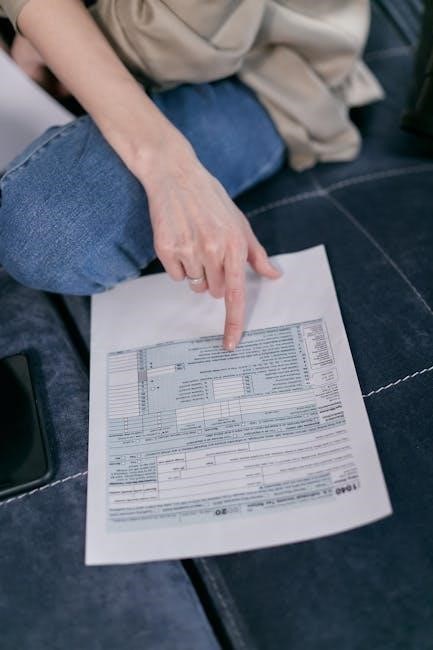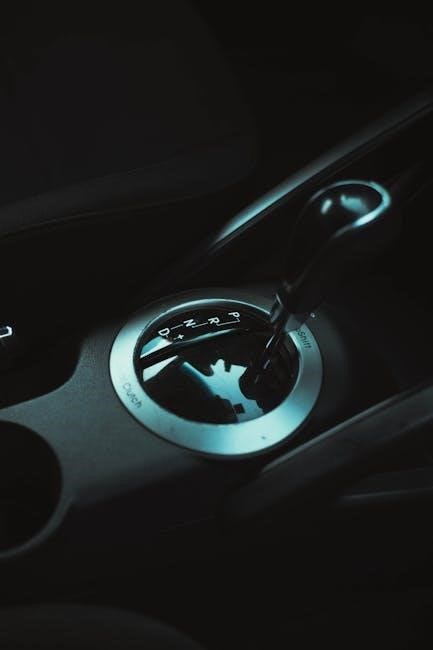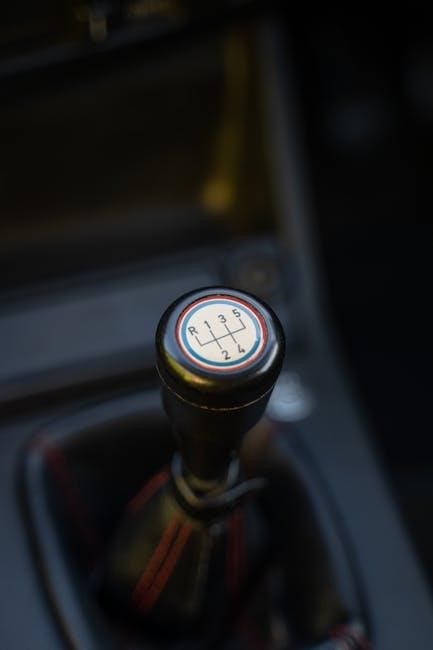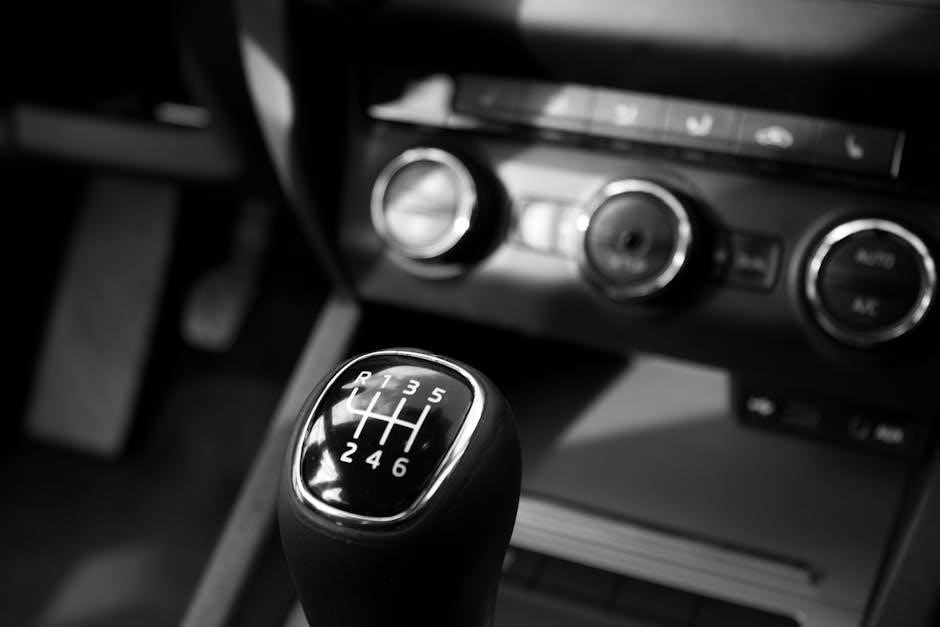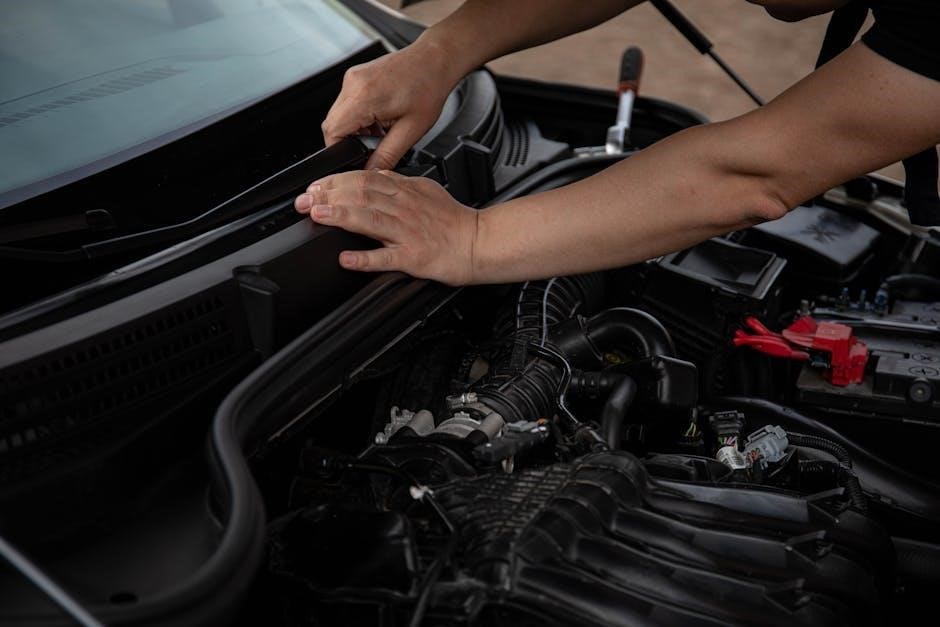Relationships are the cornerstone of human connection‚ yet navigating them in today’s fast-paced world can be challenging. This manual serves as a guide to understanding and nurturing relationships‚ offering practical advice on communication‚ trust‚ and growth. By addressing key elements like emotional intimacy and conflict resolution‚ it empowers individuals to build and maintain fulfilling connections.
- Discover how to strengthen bonds and overcome obstacles.
- Learn effective strategies for open and honest communication.
- Explore the importance of trust‚ commitment‚ and mutual respect.
Whether you’re starting a new relationship or revitalizing an existing one‚ this manual provides the tools to foster a deeper‚ more meaningful connection with your partner.
1.1 Understanding the Importance of Relationships in Modern Life
In today’s fast-paced‚ digitally driven world‚ relationships often take a back seat‚ making it challenging to nurture meaningful connections. Relationships are the cornerstone of human well-being‚ providing emotional support‚ a sense of belonging‚ and shared experiences. They help individuals grow personally and emotionally‚ fostering resilience against life’s challenges. However‚ balancing love and friendship can be complex‚ especially when transitioning from a platonic to romantic relationship. Understanding these dynamics is crucial for building and maintaining healthy‚ fulfilling connections in modern life.
1.2 The Purpose of a Relationship User Manual
A Relationship User Manual serves as a practical guide to navigating modern relationships‚ offering insights and strategies to foster meaningful connections. Its purpose is to empower individuals with tools to communicate effectively‚ build trust‚ and grow together. By addressing common challenges and providing actionable advice‚ this manual helps couples strengthen their bond and create a foundation for a fulfilling‚ long-lasting relationship. It acts as a roadmap for understanding each other’s needs and fostering mutual respect and understanding.
Communication in Relationships
Communication is the backbone of any successful relationship‚ fostering emotional connections and resolving conflicts. It involves clarity‚ empathy‚ and understanding to ensure both partners feel heard and valued.
- Clarity in expression prevents misunderstandings.
- Empathy builds emotional intimacy.
- Understanding strengthens mutual respect.
Effective communication helps navigate relationships smoothly‚ ensuring a harmonious and fulfilling connection.
2.1 The Role of Verbal Communication
Verbal communication is essential for expressing thoughts‚ emotions‚ and needs in relationships. It fosters clarity‚ understanding‚ and emotional intimacy‚ helping partners connect on a deeper level.
- Clarity ensures messages are conveyed accurately.
- Empathy helps partners understand each other’s perspectives.
- Understanding builds trust and strengthens the bond.
Effective verbal communication is key to resolving conflicts and nurturing a meaningful connection‚ ensuring both partners feel heard and valued in the relationship.
2.2 Mastering Non-Verbal Communication
Non-verbal communication‚ such as body language‚ facial expressions‚ and eye contact‚ plays a crucial role in relationships. These cues convey emotions‚ intentions‚ and attentiveness‚ often speaking louder than words. Understanding and mastering non-verbal signals can deepen emotional connections and prevent misunderstandings.
- Body language reveals confidence and openness.
- Facial expressions express emotions like happiness or concern.
- Eye contact builds trust and shows engagement.
By being aware of non-verbal cues‚ partners can communicate more effectively‚ fostering a stronger and more empathetic relationship.
2.3 Active Listening and Its Impact
Active listening is a powerful tool in relationships‚ fostering deeper connections and understanding. It involves fully engaging with your partner‚ focusing on their words‚ tone‚ and emotions without interruption. This practice builds trust‚ resolves conflicts‚ and strengthens intimacy.
- Give undivided attention to show genuine interest.
- Use verbal cues like “I see” to encourage openness.
- Reflect emotions to validate their feelings.
By actively listening‚ you create a safe space for open dialogue‚ helping your partner feel heard and valued.
2.4 Expressing Emotions Effectively
Expressing emotions effectively is crucial for a healthy relationship. It involves being honest‚ clear‚ and respectful in communicating your feelings. Using “I” statements helps avoid blame and fosters understanding. Timing and tone are key; choose moments when both partners are calm. Practice empathy and validate each other’s emotions to create a safe space for open dialogue. This fosters trust‚ intimacy‚ and mutual respect‚ strengthening your bond and resolving conflicts more efficiently.
- Be specific about your feelings and experiences.
- Avoid assumptions about your partner’s emotions.
- Stay calm to ensure productive conversations.
2;5 The Role of Technology in Communication
Technology plays a dual role in relationships‚ offering convenience but also posing challenges. Digital tools like messaging and video calls keep partners connected‚ especially when apart. However‚ over-reliance can lead to misunderstandings or emotional distance. Balancing screen time with meaningful‚ face-to-face interactions is essential. Setting boundaries‚ such as device-free moments‚ fosters intimacy and ensures quality communication. Technology should enhance‚ not replace‚ genuine human connection‚ helping couples navigate modern life while maintaining emotional closeness.
- Use technology to bridge physical gaps.
- Set boundaries to protect quality time.
- Enhance intimacy through shared digital activities.
Conflict Resolution Strategies
Conflicts are inevitable‚ but understanding their root causes and addressing them healthily is key. Active listening‚ empathy‚ and compromise foster resolution‚ strengthening the relationship over time.
- Identify the core issues driving the conflict.
- Communicate openly without blame or defensiveness.
- Seek solutions that satisfy both parties.
3.1 Understanding the Root Causes of Conflicts
Identifying the root causes of conflicts is essential for effective resolution. Often‚ misunderstandings‚ unmet expectations‚ or differing values trigger disputes. Unaddressed past experiences or external pressures can escalate tensions. Open dialogue helps uncover these underlying issues‚ fostering empathy and understanding. By addressing the core problems‚ couples can prevent recurring arguments and build a stronger foundation for their relationship. Recognizing these factors is the first step toward resolving conflicts constructively and maintaining harmony.
- Unresolved past issues can resurface and fuel current disputes.
- External pressures‚ like financial stress‚ may exacerbate tensions.
- Differing communication styles can lead to misunderstandings.
3.2 Healthy Ways to Argue
Arguing in a healthy manner is crucial for resolving conflicts without damaging the relationship. Focus on respectful communication‚ active listening‚ and avoiding blame. Use “I” statements to express feelings without accusing your partner; Set boundaries to prevent escalations and take breaks if emotions run high. Address the issue‚ not the person‚ and seek solutions together. Healthy arguments strengthen understanding and foster growth when approached with empathy and mutual respect.
- Stay calm and avoid hurtful remarks.
- Listen actively to your partner’s perspective.
- Focus on solutions rather than winning the argument.
3.3 The Art of Compromise
Compromise is a vital skill in relationships‚ allowing both partners to find mutually satisfying solutions. It involves understanding each other’s needs and priorities‚ then adjusting expectations to meet halfway. Compromise fosters a sense of fairness and respect‚ strengthening the bond. Approach disagreements with empathy‚ listen actively‚ and focus on the issue rather than the person. By prioritizing the relationship over individual desires‚ compromise becomes a tool for harmony and growth.
- Seek middle ground that honors both perspectives.
- Communicate openly about needs and boundaries.
- Celebrate agreements to reinforce positive outcomes.
3.4 When to Seek External Help
Recognizing when a relationship needs external support is crucial. If conflicts persist‚ communication breaks down‚ or emotional distress arises‚ seeking help from a therapist or counselor can provide clarity and tools for resolution. Professional guidance can help navigate complex issues‚ offering unbiased perspectives and effective strategies to strengthen the relationship. Don’t hesitate to seek help when challenges feel insurmountable.
- Persistent conflicts that don’t improve with effort.
- Emotional distress affecting daily life.
- Communication breakdowns leading to misunderstandings.
Building and Maintaining Intimacy
Intimacy is the emotional and physical connection that strengthens relationships. It requires trust‚ vulnerability‚ and consistent effort to nurture a deep‚ meaningful bond with your partner.
- Emotional intimacy fosters a sense of safety and understanding.
- Physical intimacy deepens connection and affection.
- Shared experiences enhance closeness and mutual respect.
4.1 Emotional Intimacy: The Foundation of a Strong Relationship
Emotional intimacy is the bedrock of a thriving relationship‚ fostering trust‚ vulnerability‚ and deep connection. It involves understanding and sharing feelings‚ creating a safe space for open communication. By prioritizing emotional closeness‚ partners build resilience against life’s challenges‚ ensuring a strong and enduring bond. Regular meaningful conversations and empathy strengthen this foundation‚ allowing both individuals to grow and evolve together.
- Trust and vulnerability are essential for emotional intimacy.
- Active listening and empathy deepen understanding.
- Shared experiences strengthen emotional connection.
4.2 Physical Intimacy: Beyond the Basics
Physical intimacy extends beyond physical acts‚ encompassing emotional connection and mutual respect. It’s about understanding each other’s needs and desires‚ fostering a deeper bond. Open communication and consent are crucial‚ ensuring both partners feel comfortable and valued. Physical touch can strengthen trust and affection‚ but it’s important to recognize that preferences and boundaries vary. Intimacy is a personal journey‚ and what matters most is that it feels meaningful and fulfilling for both individuals involved.
- Communication is key to understanding each other’s needs.
- Consent ensures mutual comfort and respect.
- Physical touch strengthens emotional bonds.
4.3 Maintaining Intimacy Over Time
Maintaining intimacy over time requires effort and dedication from both partners. As life progresses‚ routines and responsibilities can overshadow emotional and physical connection. Regular date nights‚ meaningful conversations‚ and shared activities help keep the spark alive. Prioritizing quality time together fosters a deeper bond‚ ensuring intimacy remains a vital part of the relationship. Adapting to changes and evolving together strengthens the connection‚ keeping it vibrant and fulfilling over the years.
- Schedule regular quality time together.
- Engage in meaningful conversations.
- Adapt to life’s changes as a team.
Trust and Commitment
Trust and commitment are foundational to lasting relationships. Building trust through consistent actions and reliability strengthens bonds. Commitment‚ rooted in mutual respect‚ ensures a dedicated partnership‚ fostering a fulfilling connection.
- Trust is built through consistent actions and reliability.
- Commitment ensures a dedicated and enduring partnership.
- Mutual respect strengthens the bond between partners.
5.1 Building Trust from the Ground Up
Trust is the foundation of any successful relationship‚ requiring effort and dedication from both partners. It begins with transparency‚ consistency‚ and reliability. By being honest and following through on commitments‚ individuals create a secure environment for trust to grow. Open communication and active listening are essential‚ as they foster understanding and empathy. Over time‚ these actions build a strong‚ unshakable bond‚ allowing partners to feel safe and supported in their relationship.
- Honesty and transparency lay the groundwork for trust.
- Consistency reinforces reliability and dependability.
- Active listening and empathy strengthen emotional connections.
5.2 Signs of a Trustworthy Partner
A trustworthy partner consistently demonstrates honesty‚ transparency‚ and reliability. They maintain open communication‚ admit mistakes‚ and take responsibility for their actions. Their words align with their deeds‚ showing dependability. Respect and empathy are evident in their interactions‚ fostering a safe and supportive environment. A trustworthy partner values mutual growth and stands by their commitments‚ even in challenging times.
- Honesty and transparency in their words and actions.
- Consistency in keeping promises and being reliable.
- Accountability for mistakes and willingness to grow.
- Respect and empathy in all interactions.
5.3 Commitment: The Cornerstone of a Lasting Relationship
Commitment is the foundation of a enduring relationship‚ reflecting a deep dedication to mutual growth and shared goals. It involves loyalty‚ perseverance‚ and a willingness to overcome challenges together. A committed partner prioritizes the relationship‚ fostering trust and stability. This unwavering dedication creates a safe environment for both individuals to thrive‚ ensuring the relationship remains resilient through life’s ups and downs.
- Loyalty and dedication to the relationship.
- Shared goals and mutual aspirations.
- Teamwork in overcoming challenges.
5.4 Mutual Respect and Its Role in Trust
Mutual respect is the bedrock of trust in any relationship‚ fostering a culture of understanding and empathy. When both partners value each other’s opinions‚ boundaries‚ and individuality‚ trust naturally flourishes. Respect ensures open communication and a secure environment‚ where both individuals feel heard and appreciated. It strengthens the bond‚ allowing the relationship to grow on a foundation of reliability and admiration.
- Valuing each other’s opinions and boundaries.
- Supporting individuality and personal growth.
- Fostering a secure and trusting relationship environment.
Personal Growth and Development
Personal growth is essential for a thriving relationship. Encourage individual goals and support each other’s aspirations. This fosters a stronger bond and mutual respect together.
6.1 The Importance of Individual Growth
Individual growth is vital for personal and relational well-being. It allows each partner to evolve‚ bringing new perspectives and enthusiasm to the relationship. By supporting personal aspirations‚ couples strengthen their bond and foster a dynamic‚ evolving connection. Encouraging hobbies‚ learning‚ and self-improvement ensures both partners remain fulfilled and engaged. This growth prevents stagnation and keeps the relationship vibrant‚ creating a foundation for long-term satisfaction and mutual respect.
- Promotes self-fulfillment and happiness in both partners.
- Fosters resilience and adaptability in life’s challenges.
- Encourages a growth mindset‚ enriching the relationship.
6.2 Supporting Your Partner’s Growth
Supporting your partner’s growth fosters a fulfilling and evolving relationship. Encourage their aspirations‚ celebrate milestones‚ and offer constructive feedback; Being a proactive partner creates a safe space for them to explore new opportunities and develop personally. This support strengthens trust and deepens emotional intimacy‚ ensuring both partners thrive together. By prioritizing their growth‚ you invest in a future filled with shared success and mutual satisfaction.
- Encourage open communication about their goals and aspirations.
- Celebrate their achievements to build confidence and motivation.
- Offer support during challenges to help them grow.
6.3 Setting Shared Goals for the Future
Setting shared goals strengthens your relationship by creating a unified vision for the future. Collaborate on aspirations‚ whether personal‚ financial‚ or lifestyle-related‚ to foster alignment and purpose. Regularly discuss and reassess these goals to ensure they remain relevant and achievable. This process builds trust‚ commitment‚ and mutual respect‚ ensuring both partners feel heard and valued. Shared goals not only enhance teamwork but also deepen emotional intimacy‚ guiding you toward a harmonious and fulfilling life together.
- Communicate openly about individual and shared aspirations.
- Align goals to create a unified vision for the future.
- Regularly review and adjust goals to maintain relevance.
Navigating Challenges Together
Navigating challenges together strengthens relationships by fostering teamwork and understanding. Facing difficulties as a united front builds resilience and deepens emotional bonds‚ ensuring a stronger connection.
- Teamwork enhances problem-solving and mutual support.
- Resilience grows through shared experiences and adaptability.
- Understanding strengthens trust and emotional intimacy.
7.1 Handling Life Transitions as a Team
Life transitions‚ such as moving‚ career changes‚ or starting a family‚ can strain relationships if not navigated thoughtfully. Approaching these changes as a team fosters unity and resilience.
- Open communication helps align expectations and ease anxieties.
- Shared goals create a sense of purpose and direction.
- Mutual support strengthens the bond during uncertain times.
By facing transitions together‚ couples can grow closer and build a stronger‚ more adaptable relationship.
7.2 Dealing with External Pressures
External pressures‚ such as work stress‚ family expectations‚ or financial strain‚ can impact relationships. Addressing these challenges together strengthens resilience and understanding.
- Open dialogue helps identify and share burdens.
- Teamwork fosters a united front against external stressors.
- Setting boundaries protects the relationship from outside influences.
By addressing external pressures collaboratively‚ couples can maintain harmony and deepen their connection despite life’s challenges.
7.3 Financial Challenges and Relationship Health
Financial challenges can strain relationships‚ causing stress and tension. Open communication about money matters is essential to avoid misunderstandings and build trust.
- Discuss financial goals and priorities together.
- Create a shared budget to manage expenses effectively.
- Address disagreements calmly and seek compromises.
By tackling financial challenges as a team‚ couples can strengthen their bond and ensure a healthier‚ more stable relationship.
Commitment and the Future
Commitment is the foundation for a lasting relationship‚ ensuring both partners are dedicated to growth and shared goals. Planning together fosters stability and a promising future.
8.1 Long-Term Planning in Relationships
Long-term planning strengthens relationships by creating a shared vision for the future. Discussing goals‚ such as career aspirations‚ family plans‚ and financial strategies‚ fosters alignment and trust. Setting milestones together ensures both partners are committed to mutual growth. Regularly revisiting these plans allows for adjustments‚ keeping the relationship dynamic and resilient. Open communication about life transitions and future aspirations builds a foundation for enduring partnership and shared success.
- Align personal and shared goals for a unified path forward.
- Plan for financial stability and major life decisions.
- Communicate openly about aspirations and expectations.
Long-term planning not only secures a stable future but also deepens emotional connection and commitment.
8.2 The Role of Children in a Relationship
Children bring immense joy and fulfillment to a relationship‚ but they also introduce new challenges. Raising a family requires strong communication‚ teamwork‚ and shared values. Both partners must align on parenting styles‚ disciplinary approaches‚ and emotional support. Balancing individual needs with family responsibilities is crucial. Open dialogue about expectations and responsibilities ensures harmony. Children strengthen the bond between partners‚ fostering a sense of purpose and unity. However‚ maintaining intimacy and personal connection remains essential to sustain a healthy relationship.
- Communicate openly about parenting styles and expectations.
- Share responsibilities to avoid burnout and resentment.
- Prioritize quality time as a couple and as a family.
Children enrich relationships‚ but nurturing both the family and the partnership requires effort and dedication.
8.3 Growing Together: Evolving as a Couple
Growing together as a couple involves embracing change and supporting each other’s personal and shared goals. As individuals evolve‚ the relationship must adapt to maintain harmony and connection; Open communication about aspirations and challenges fosters understanding and unity. Celebrating milestones and learning from setbacks strengthens the bond. By prioritizing growth and evolution‚ couples can build a resilient and fulfilling relationship that stands the test of time.
- Embrace change and support each other’s goals.
- Communicate openly about aspirations and challenges.
- Celebrate growth and learn from setbacks together.
Evolution as a couple ensures a dynamic and lasting connection.
This manual serves as a guide to nurturing relationships through effective communication‚ trust‚ and mutual growth. By applying these principles‚ couples can build a resilient and fulfilling connection that stands the test of time. Embrace the journey of growth and evolution together‚ ensuring a dynamic and lasting bond.
9.1 Summarizing Key Takeaways
- Effective communication is essential for understanding and connection.
- Trust and commitment form the cornerstone of a lasting relationship.
- Emotional and physical intimacy foster a deeper bond.
- Conflict resolution and compromise are vital for growth.
By applying these principles‚ couples can create a fulfilling and enduring partnership.
9.2 Final Thoughts on Building a Successful Relationship
Building a successful relationship requires effort‚ dedication‚ and a willingness to grow together. By fostering open communication‚ nurturing trust‚ and embracing intimacy‚ couples can create a strong foundation. Understanding each other’s needs and navigating challenges as a team strengthens the bond. Remember‚ relationships evolve‚ and adaptability is key. With commitment and mutual respect‚ partners can overcome obstacles and build a lasting‚ fulfilling connection that brings joy and satisfaction to both lives.
- Commitment and mutual respect are essential for longevity.
- Emotional intelligence and empathy foster deeper understanding.
- Growth and adaptability keep the relationship vibrant.
Ultimately‚ a successful relationship is a journey of love‚ learning‚ and shared experiences.













